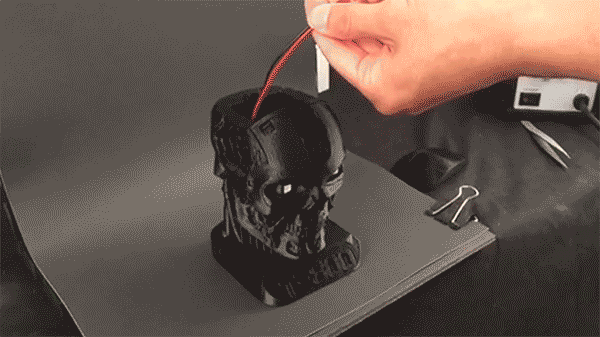Pumpkins just not cutting it for you this year?
If you want a unique, hand-made Halloween decoration – and happen to have access to a 3D printer – Duke graduate student Patrick Flowers has just the project for you: this 3D-printed Terminator head, complete with shining, blood-red eyes.
[youtube https://www.youtube.com/watch?v=llDaqaicGGk]
Flowers, a PhD candidate in Benjamin Wiley’s lab, is not spending his time studying early eighties action flicks or the Governator’s best break-out roles. Instead, he and his labmates are working hard to brew up highly-conductive, copper-based materials that can be 3D printed into multilayer circuits – just like the one powering this Terminator’s glowing LED eyes.
Their latest copper concoction, which they have named “Electrifi,” is about 100 times more conductive than other materials on the market. The team has a taken out a provisional patent on Electrifi and also started a company, named Multi3D, where 3D-printing aficionados can purchase the material to include in their very own devices.

This X-ray view of Terminator’s head, collected with Duke SMIF’s Micro CT scanner, shows the embedded 3D circuit powering his LED eyes.
Creating a conductive, 3D-printable material is a lot trickier than just throwing some copper into a printer and going to town, Flowers said.
“Copper is really conductive originally, but if you try to extrude it out of a hot nozzle like you have to do in order to do this 3D printing, then it quickly loses all its properties,” Flowers said. And conductive materials that can stand the heat, like silver, are too expensive to use on any sort of scale, he added.
To bring the benefits of 3D printing to the world of electric circuits, Flowers and his labmates are experimenting with mixing copper with other materials to help it stay conductive through this extrusion process.
“This lab has a long history of working with copper – copper nanowires, copper particles, copper nanoparticles – so we’ve got a lot of little tricks that we use to maintain the conductivity,” Flowers said.
The team is currently testing the limits of their new material and plans to publish their findings soon. In the meantime, Flowers is busy exploring the other capabilities of Electrifi — outside of plastic android noggins.
“The circuit inside this guy is really simple, but it does show the capabilities of the material: it is embedded, it shows that I can go down, over, up, out, and go to a couple of eyes,” Flowers said. “Now I want to expand on that and show that you can make these really complicated embedded structures that have multiple layers and multiple components, other than just LEDs.”


Post by Kara Manke
